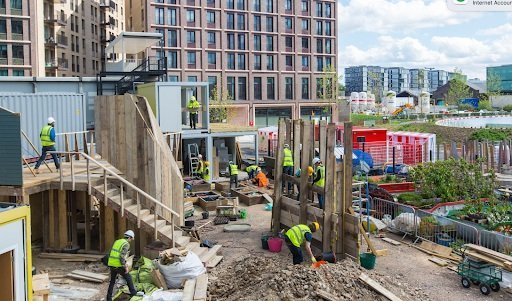Gardens of a thousand hands
Recently I had a call with Jan Kattein, the architect Global Generation has worked with since 2015 when we collaborated to make the last Skip Garden. Jan is writing a book called London made by Londoners, and he was interviewing me for a chapter about Global Generation. We spoke of the many ingredients that go into the gentle form of activism that our work has become and how on so many different levels the work is about growing relationships between different people and between all of us and the natural word. Now I am here in Aotearoa New Zealand, our conversation brought to mind the Maori concept of Kaitiaki tanga , which is about the kind of stewardship needed to sustain cultural and environmental relationships. The word kaitiaki means carer and it is used interchangeably between carer of people and carer of Te taiau (the environment).
Global Generation’s Skip Garden Number 3 built in collaboration with Jan Kattein and UCL Bartlett School of Architecture
What this kind of care is about has been an ongoing learning journey in which I discovered that it is not just the physical things that have been created that are important, like the Skip, Paper, Story and now Floating Gardens, but perhaps more importantly, it is how they have been created. I recounted to Jan the story of how the very first Skip Garden was made. It was opposite St Pancras Station on the site now occupied by one of the many Google buildings that populate King’s Cross. We were given the keys to the hoarding, behind which lay a dusty site surrounded by construction. The Guardian Newspaper had just moved into the area, and much of the garden was made through a big build day, where the senior leadership team joined primary and secondary pupils, construction workers and young women from a hostel in Camden. Individually we were somewhat at sea about how the day would go, however we discovered that together we knew a lot. Physically the garden moved forward tremendously, but it was more than that. One of our young Generators at the time, Zakariya Sharif Nur captured something of why the day felt so special, he wrote “what we did today was create a living atmosphere.” Tim Brooks, MD of the Guardian at the time, put it this way; “it was like a dream thing and at the same time it was very practical.” From that day on the garden and all the gardens that came after it became as Paul Richens, our head gardener back then said, ‘gardens of a thousand hands.’
It was heartening to see this same many hands approach at work in the reports I read of GG’s most recent project, The Floating Garden. In her blog Laura who manages the barge, pays homage to the young people who envisioned the design and worked on the transformation of what had been a floating cinema on a canal barge into an educational garden . Now I am here in Aotearoa New Zealand. Together with my husband Rod, a former primary school teacher, who also worked with Global Generation, we are in the very early stages of working on a wetland and riparian forest restoration project on land that has been in my family for several generations. Whilst it is not a Global Generation project, we carry the spirit and the promise of the GG way of working with us. From the get go we have been helped by local volunteers, who have given us both labour and confidence as we feel our way forward. So far our volunteers, great as they are, have been over 40 and many over 60. We have missed working with children and young people. Just as I was beginning to wonder if we would ever achieve a true intergenerational mix, an email arrived from Enviro Schools, a nationwide environmental education initiative, asking if we might be one of the educational sites in their network. I imagine the day, when we might have a group of young ambassadors and we will find ways to overcome the challenges of the time zone difference and they will be able to connect with the young people who bring GG’s gardens to life in London.
Laura describes how she is ‘Learning by Doing’ and despite my previous experience I feel very much like that. I strive to achieve that delicate and sometimes nerve wracking balance of being organised enough to inspire confidence, porous enough to allow others to be involved and not too overwhelmed by the many things I don’t know and certainly can’t achieve on my own. Instinctively it has always felt important to work in a collaborative way but I couldn’t always articulate why. In an infographic video called’ the Home we Build Together’ , Rabbi Johnathan Sacks, sets out some of the ways where history has often fallen short in benevolent attempts to integrate people of different cultures and social circumstances; creating unhelpful hierarchies in the name of charity, isolating individuals and segregating cultures. His description of what works, speaks to what we have experienced in the build of many of Global Generation’s gardens. Sacks says, “Building leads to belonging, when we build together we bond.”
Rod and I are currently gathering materials for a shade house, shelter and composting toilet for our project. These first structures will create a foundation for us to host the local enviro schools. Like many of Global Generations’ projects, our budget is slim and gifts of time and materials are vital. A few weeks ago I was standing in the middle of the local dump looking at an enormous pile of rubble. Somewhere buried in the middle were sheets of corrugated iron but how on earth could I reach them. As I was beginning to rummage in an out-of- bounds to the public area, a burly guy appeared. He was dressed in orange and black and looked disconcertingly official . However my luck was in and without much persuasion he climbed into his huge digger, pulled the pile apart and gave us our materials. The gathering of materials that have had other lives is not just about saving money or even being the environmentally sound thing to do. It is the stories these materials carry that help create a living atmosphere. Through a someone knows someone connection we now also have a pile of long posts that not so long ago were supporting the vines in a local vineyard.
Glasshouse Lantern, in the last Skip Garden
Global Generation’s gardens have always stood out in juxtaposition to the clean lines of the modernist structures that surround them. Many of these high rise buildings designed for materials that have been, as Australian eco-philosopher Freya Matthews describes, boiled down to a neutral substrate, with unrecognisable histories. I like to think that amidst their ramshackle edges our gardens are truly gardens of a thousand hands with a thousand stories to tell.






The everyday often gets overlooked, doesn’t it? We walk past spaces, objects, and people without a second thought—but these small, everyday moments hold the power to create real change.